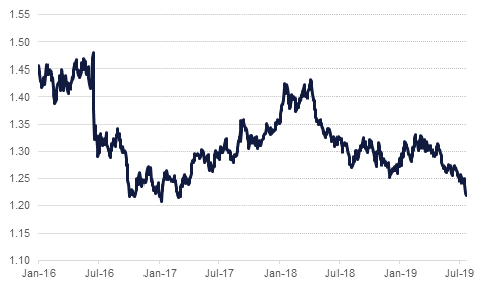
GBP continued to plummet yesterday, falling over 1% against the dollar, euro, and most other currencies, and reaching a two-year low of 1.2160 overnight. While the USD is firm overall approaching the Federal Reserve’s FOMC meeting, by far the most significant factor hurting sterling is the ratcheting up of no-deal Brexit preparations by the new Boris Johnson government, as it makes clear that it will leave the EU on the 31st October without a deal if the EU does not change key aspects of the deal that was voted down three times in the UK parliament earlier this year. With no sign of Brussels bending, in the knowledge that Johnson is in a weak position with a working majority of just two seats, the markets are realizing that this latest round of brinkmanship may no longer be a game of bluff, with a hard exit and maybe even a general election both very real possibilities. The pound appears to be on course to re-test the 2016 post-referendum lows of 1.1750 against the USD, and may even fall lower than that in the event of all of these things unfolding.
Meanwhile the Bank of Japan kept interest rates unchanged this morning, maintaining its Policy Balance Rate at -0.1% and its 10-year JGB yield target at about 0% The BOJ downgraded its inflation outlook a little and repeated that it won’t hesitate to take extra monetary policy steps if necessary.
Broad money supply growth slowed to 0.1% m/m and 3.6% y/y in Saudi Arabia in June. Faster growth in demand deposits was offset by a m/m decline in longer term SAR and FX deposits last month. Private sector credit growth contracted -0.6% m/m, with annual growth slowing to 2.6% y/y in June. Net foreign assets (NFAs) at the central bank declined for the first time since February, falling –USD 4.3bn to USD 506.5bn in June, but are still up USD 17bn since the start of this year. NFAs have been boosted by an improving current account balance as well as portfolio inflows and debt issuance in H1 2019.
 Source: Bloomberg, Emirates NBD Research
Source: Bloomberg, Emirates NBD Research
Fixed Income
Treasuries traded flat as volumes dropped ahead of the Federal Reserve meeting scheduled for this week. Yields on the 2y UST, 5y UST and 10y UST closed at 1.85% (flat), 1.84% (flat) and 2.06% (-1 bp) respectively.
Regional markets saw a little bit of profit booking at the start of the week. The YTW on the Bloomberg Barclays GCC Credit and High Yield index rose 2 bps to 3.42% and credit spreads widened 4 bps to 147 bps.
S&P said that it has assigned A- rating to the USD 3bn sukuk issuance program of Sharjah Islamic Bank.
FX
GBPUSD is trading below the 1.22 level this morning following assertions from Prime Minister Boris Johnson that he would not shy away from a no-deal Brexit while ensuring that the UK leaves the European Union on the 31st October deadline. His comments that he would not meet EU negotiators unless they agreed to abandon the backstop have stoked investor fears and resulted in further pressure on sterling. As we go to print, GBPUSD is trading near a two-year low of 1.2176 and remains vulnerable to further losses.
Elsewhere, JPY remains little changed following the Bank of Japan monetary policy meeting, at which Governor Kuroda and fellow policy makers made no change to the status-quo.
Equities
Developed market equities closed lower as investors remained cautious ahead of the Fed meeting later this week and as earnings remained mixed. The S&P 500 index dropped -0.2% while the Euro Stoxx 600 index closed flat.
Regional markets remained largely positive. The DFM index added +1.2% to close at its highest levels since August 2018. The rally continues to be driven by strength in real-estate stocks with Emaar Properties adding +3.9%. ADCB dropped -1.0% after the bank reported a decline in Q2 2019 profits. The Tadawul dropped -1.5% as corporate earnings continues to remain weak.
Commodities
Oil prices pushed higher as markets look to the US Federal Reserve later this week with expectation of a 25bps cut. Commodities should benefit from the back of central bank’s globally offering looser monetary policy although we are doubtful how effective lower rates or more quantitative easing will be in turning around real economic performance. Brent prices rallied 0.4% after having fallen by as much as 0.85% intraday. Prices are extending gains above USD 64/b in early trade today. WTI futures rallied more than 1.1% and are up over USD 57/b at the moment.
Gold prices are hewing close to USD 1,420/troy oz ahead of the Federal Reserve. Unless the commentary from the Fed surrounding a rate cut is substantially more dovish, the effect of the cut may already have been priced into the gold market and any spike upward could be temporary. Other factors this week—such as the resumption of US-China trade talks—are likely to be more significant for gold.